2020-04-23
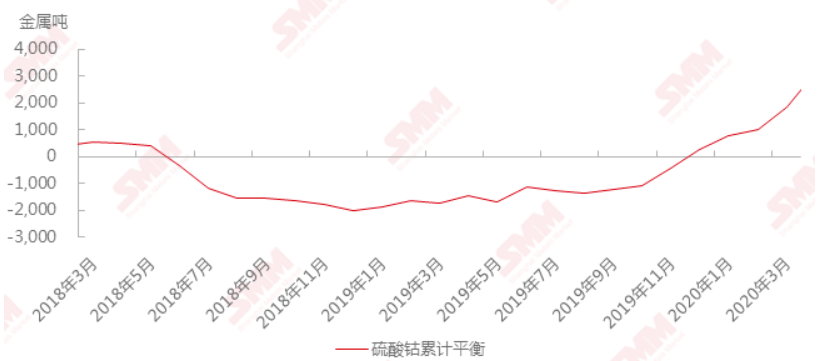
[industry] downstream power demand is low, and cobalt sulfate inventory continues to be under pressure
On the supply side, in March 2020, China's cobalt sulfate output was 35000 tons of metal tons, up 94% month on month and down 10% year on year. In March, the operating rate of cobalt salt plants basically recovered to 70-80%. Affected by the epidemic, the downstream demand was low, and some large plants did not return to the normal operating level. A few cobalt salt plants increased their orders for cobalt sulfate in March, and some production lines were switched from cobalt chloride to cobalt sulfate. The overall supply of the market increased, but the demand side was more affected by the epidemic, and the pressure on cobalt sulfate inventory continued to increase. SMM predicts that the supply of cobalt sulfate in China will increase slightly in April 2020, about 3700 tons of metal tons, an increase of 6% month on month and a decrease of 14.5% year on year. It is mainly because a large cobalt salt plant started late in March due to the serious impact of the epidemic, the supply of cobalt salt returned to normal in April, and the inventory pressure of cobalt sulfate continued to increase in April.
On the demand side, in March 2020, China's total demand for cobalt sulfate was 2400 tons of metal tons, of which the output of ternary precursor corresponded to the demand for cobalt sulfate of 1700 tons of metal tons, up 68% month on month and down 43% year on year. In March, the operating rate of ternary precursor enterprises returned to normal, the order increment in the digital market, and the purchase demand for cobalt sulfate increased relatively. However, affected by the overseas epidemic in late March, the price of cobalt metal fell seriously, and the terminal demand was still weak. The precursor manufacturers purchased cautiously, and the demand for cobalt sulfate gradually decreased. SMM expects that the power market will recover slowly in April, and the purchase volume of the digital market may decline due to the impact of overseas exports. In April, the output of ternary precursor corresponds to the demand for cobalt sulfate of about 16000 tons of metal tons.
SMM predicts that China's cobalt sulfate balance in March 2020 shows an increase in inventory, with an additional inventory of 0900 tons of metal tons in that month, and a cumulative increase of 1900 tons of metal tons since 2018. According to customer feedback, the export of cobalt sulfate in February was greatly affected by the domestic epidemic, mainly due to logistics constraints. SMM expects the export data of cobalt sulfate in February to be 150 metal tons, and the cumulative cobalt sulfate in February is about 206 metal tons; The export of cobalt sulfate in March was mainly affected by the overseas epidemic, and the export data of cobalt sulfate in March is expected to be 200 metal tons. (source: SMM)
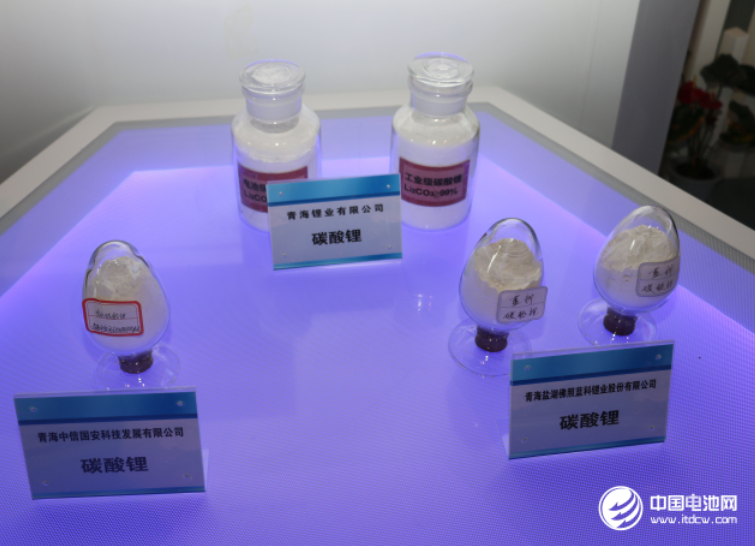
[market] cobalt salt plant intends to support lithium price or approach the bottom
Battery and downstream terminal market: in the power market, the overseas epidemic has not yet reached the inflection point, European and American car companies may delay the resumption of work, and the export of domestic head battery factories will be reduced. Recently, domestic auto enterprises have taken measures such as online live broadcast and preferential car purchase to promote the sales of new energy vehicles. For example, the price of many models of GAC has been reduced by 10%, which shows that auto enterprises want to recover their past sales as soon as possible after the blow in the first quarter. In addition, the competition between car companies is intensifying. Tesla's domestic Model3 has a long-term subsidy of 339050 yuan and opened a tmall flagship store. This pricing strategy is another big impact on domestic car companies. In the consumer market, the overseas epidemic has led to the closure of ports in Southeast Asia and South Africa, which has an impact on the export of domestic low-end digital products. According to SMM, supermarkets in some European and American countries, such as Wal Mart, have a slight increase in demand for digital consumer goods. On the whole, the export volume of consumer products may continue to decrease by about 20% in April.
Ternary materials: the price of ternary materials remained unchanged last Wednesday. Last week, the price of upstream precursors was basically stable, and the price of dynamic ternary materials remained unchanged. Affected by the overseas epidemic, the export orders of end consumer goods and consumer batteries were reduced, and the competition among Sanyuan material factories was fierce. Some manufacturers sold digital 523 at a price below 90000. The market price was chaotic, the bargaining power of material factories was weak, and the digital price continued to weaken. The price of SMM ternary material (type 523) is 119-125 thousand yuan / ton, with the average price unchanged from the previous week. The price of SMM ternary material (type 622) is 136000-142000 yuan / ton, with the average price unchanged from the previous week.
Lithium iron phosphate: the price of lithium iron phosphate last week was flat compared with the previous week. The price of lithium carbonate fell slightly last week, which had a limited impact on the price of lithium iron, and the price of lithium iron remained unchanged. The orders in the downstream power market have recovered, and the orders in the energy storage market have also increased, but the prices of battery manufacturers are seriously depressed, and the prices of energy storage products are low. Last week, the price of SMM lithium iron phosphate (power type) was 38000-42000 yuan / ton, with the average price unchanged from the previous week.
Future forecast: in terms of cobalt, the order of cobalt salt plant in April has been basically completed. Based on the expectation of the development of overseas epidemic, the cobalt salt plant intends to support the price, and the short-term price remains stable. In terms of lithium, the current terminal demand is poor, and the inventory and price of upstream enterprises are under pressure. SMM predicts that cobalt raw materials in the future may face problems such as delayed arrival in Hong Kong, and market sentiment fluctuations may affect the trend of cobalt prices next month; At present, most lithium salt plants still maintain a high operating rate, and the subsequent sales may be guaranteed by reducing prices, but the space for price decline is very limited. (source: Shanghai Nonferrous Metals network)
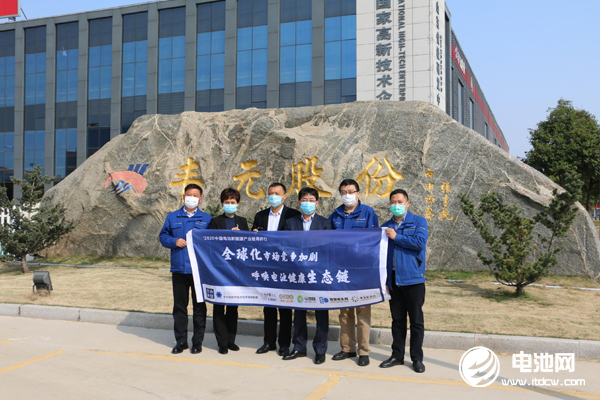
[performance] the revenue of lithium cathode materials of Fengyuan Co., Ltd. in 2019 was 206 million yuan, accounting for 45% of the company's main revenue
On April 19, Fengyuan Co., Ltd. (002805) released its 2019 annual report. During the reporting period, the company steadily carried out oxalic acid business and actively developed lithium battery cathode material business. Benefiting from the capacity and sales growth of lithium battery cathode material sector, the company achieved an annual operating revenue of 457.966 million yuan, an increase of 72.94% year-on-year, of which the revenue of lithium battery cathode material was 205.8606 million yuan; The total profit was 13.9947 million yuan, a year-on-year decrease of 23.43%.
According to the development strategy of Fengyuan Co., Ltd., after years of development, the company has initially formed two business patterns with oxalic acid business and lithium battery cathode material as the main business. During the reporting period, some production lines of Fengyuan lithium energy lithium iron phosphate and ternary materials were put into operation successively, and the products were put on the market to achieve stable supply. The operating revenue of cathode materials business has accounted for 45% of the company's main revenue. With the reduction of product costs caused by the expansion of cathode material production capacity and the improvement of product performance with the help of international R & D team, Fengyuan lithium energy will launch cathode material products with more market competitiveness in the future, gradually expanding market share, so as to realize the rapid development of the company.
In terms of lithium battery cathode material business, under the leadership of Dr. Jin Youcheng and Dr. duanzhenzhong, the former directors of lg-gsem Research Institute, the company has established an international R & D team with rich experience and outstanding technical capabilities. The developed lithium battery cathode material has reached the industry-class level in key performance indicators such as energy density, specific surface area, thermal stability and so on. The company's lithium battery cathode material business is implemented by Shandong Fengyuan lithium energy technology Co., Ltd., a wholly-owned subsidiary. The projects under implementation include the construction project of lithium iron phosphate, a cathode material for lithium batteries with an annual output of 10000 tons, the construction project of ternary cathode material for lithium ion power batteries with an annual output of 5000 tons, and the high nickel ternary material project for lithium ion batteries with an annual output of 10000 tons. The company pays attention to the progressiveness of production equipment and the intellectualization of production process. It cooperates with first-class suppliers in the industry at home and abroad to purchase cutting-edge production equipment and build intelligent production lines. Among them, the production process of lithium iron phosphate adopts nano pre dispersion technology, and the production equipment is the first in the industry to adopt the whole process digitalized lithium iron phosphate automatic production line, advanced centralized control system (DCS system), The main equipment of the ternary cathode material production line is from internationally renowned manufacturers such as takasha and Hosokawa in Japan. After a series of steps of early capacity construction, pilot production and capacity ramp up, the company has put into operation 8000 tons of cathode materials annually, including 5000 tons of lithium iron phosphate series and 3000 tons of nickel cobalt manganese series. (source: battery bairenhui battery network)
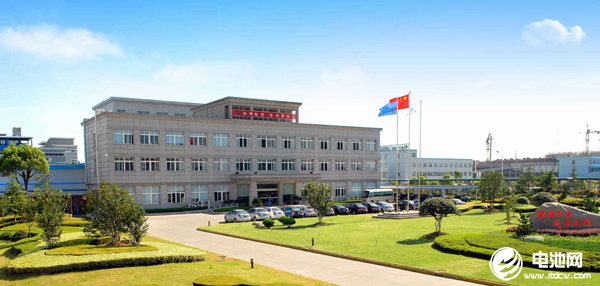
[performance] gross profit margin of cobalt products increased, and the net profit of Huayou cobalt industry in the first quarter was 184million yuan
On April 15, Huayou cobalt (603799) disclosed the first quarter report of 2020. The company achieved an operating revenue of 4.424 billion yuan in the first quarter of 2020, an increase of 0.53% year-on-year; The net profit was 184 million yuan, a year-on-year increase of 1385.10%. The basic earnings per share is 0.17 yuan.
Earlier, Huayou cobalt said in the performance forecast that the performance forecast was mainly due to the good results achieved by the implementation of the company's business strategy of high-end products and industrial integration. With the relative stabilization of the price of cobalt products, the gross profit margin of cobalt products increased, while the gross profit margin and sales volume of copper products also increased.
Huayou cobalt achieved an operating revenue of 18.853 billion yuan in 2019, with a year-on-year increase of 30.46%; The net profit attributable to shareholders of listed companies was 120million yuan, a year-on-year decrease of 92.18%. The net profit in the first quarter of this year has exceeded that of last year.
It is understood that Huayou cobalt industry produced 28305 tons of cobalt products in 2019, with a year-on-year increase of 16.22%, 67695 tons of copper products, with a year-on-year increase of 84%, and 13164 tons of ternary precursor products, with a year-on-year increase of 2.6%. (source: battery bairenhui battery network)
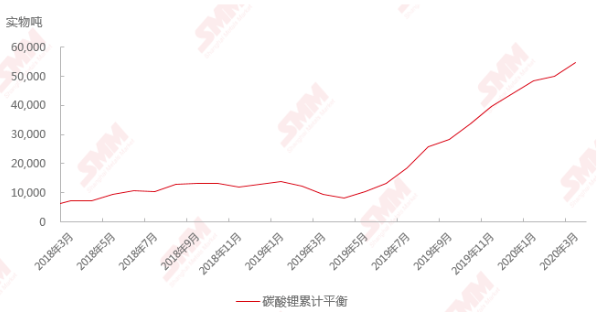
[Focus] there is a "fault" in the growth rate of lithium carbonate supply and demand. Irrational production increases the pressure on industry inventory
On the supply side, with the gradual control of the domestic epidemic in March and the smooth resumption of work in various regions, the lithium carbonate supply side increased significantly in March. The operating rate in Jiangxi, where the epidemic was relatively serious, has recovered rapidly. With the warmer weather in Qinghai, the operating rate of some enterprises has also increased. According to SMM, major smelters in Sichuan and Qinghai arrange maintenance plans in mid to early April, with maintenance time ranging from one week to half a month. At present, the terminal demand has not improved significantly, and the enterprise has insufficient power for full production, but: 1) some spodumene smelters are still completing production tasks when there are few orders; 2) Compared with pyroxene enterprises, mica and brine raw materials currently have a certain cost advantage, and the operating rate continues to remain high. At present, there is no plan to reduce the operating rate of lithium salt enterprises in April. According to the current production situation of various enterprises, SMM predicts that the output of lithium carbonate in China in April was 15000 tons, up 12.7% month on month and 26.5% year on year.
On the demand side, the market demand showed an obvious inflection point with the spread of the overseas epidemic in mid March. In terms of consumer batteries, a number of terminal factories in Southeast Asia announced shutdown in mid and late March, while a large number of export orders were facing cancellation, and the upstream orders for lithium manganate, lithium cobalt oxide and digital ternary were affected, and the operating rate was controlled from mid and late March. In terms of power batteries, the operating rates of vehicle manufacturers and battery enterprises continue to recover, but due to the fact that terminal consumption has never improved, battery enterprises began to postpone or cancel material orders in mid to late March, choosing to give priority to the digestion of material inventory. Multiple factors led to sporadic orders for battery grade lithium carbonate and a decline in orders for industrial grade lithium carbonate in March. According to the industry, SMM said that the current operating rate of power battery enterprises remained low, and the ternary demand was temporarily suspended in April; The demand for lithium iron phosphate energy storage may increase, and the demand for lithium carbonate is expected to increase slightly to 9800 tons in April.
SMM predicts that if lithium salt enterprises still have no plans to reduce production, the pressure on the industry to accumulate reserves will increase significantly in April. Since 2018, the cumulative inventory of lithium carbonate in China has exceeded 50000 tons (including the part used for causticization to lithium hydroxide). SMM believes that irrational production behavior has a limited time to maintain. Under the circumstances of limited cost support and limited space for price decline, the industry may enter the stage of active production reduction in the second quarter. (source: Shanghai Nonferrous Metals network)
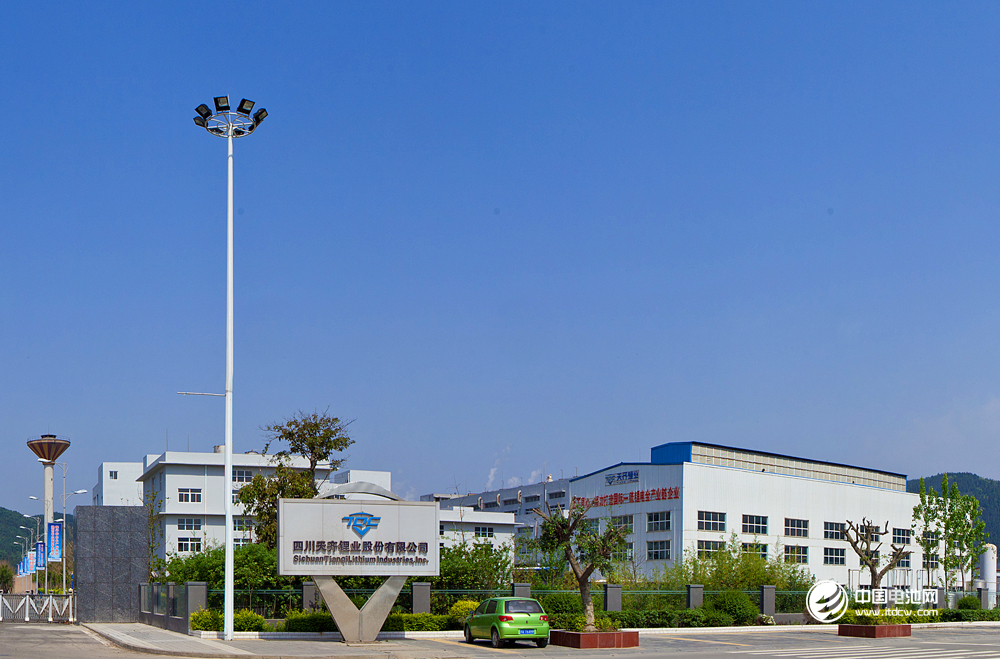
[performance] Tianqi lithium expects a loss of 450million-510million in the first quarter and wants to sell part of the equity of talison lithium
On April 15, Tianqi lithium (002466) disclosed the performance forecast for the first quarter of 2020. The company's net profit loss attributable to shareholders of listed companies was 450million to 510million yuan, and the profit for the same period last year was 111million yuan.
Tianqi lithium said that the main reasons for the decline of the company's performance in the reporting period were: 1. During the reporting period, due to the impact of multiple adverse factors such as the industry cycle adjustment and the outbreak of COVID-19, the price of lithium products fell, as well as the poor logistics and the delayed commencement of downstream customers, resulting in a decline in sales. The above factors led to a decline in operating income and gross profit margin during the reporting period compared with the same period last year, resulting in a decline in the company's net profit attributable to shareholders of listed companies. 2. During the reporting period, the exchange rate of the Australian dollar against the US dollar decreased significantly, resulting in a significant increase in the amount of exchange losses of financial expenses in the current period compared with the same period last year. 3. With the gradual improvement of the domestic epidemic, downstream customers have resumed work and production, and the poor logistics has been gradually alleviated. The company will actively carry out work deployment while doing a good job in epidemic prevention and control, and strive to reduce the adverse impact of the epidemic.
It is worth noting that, according to people familiar with the matter, Tianqi lithium is planning to sell 51% equity of talison lithium to repay the debt accumulated in the process of global expansion.
It is reported that talison lithium owns the greenbushes spodumene mine in Western Australia. It is reported that the total resource of greenbushes spodumene mine is 165.1 million tons, equivalent to 8.33 million tons of lithium carbonate equivalent; The total reserves of lithium ore are 86.4 million tons, equivalent to 5million tons of lithium carbonate equivalent. It is the largest high-grade spodumene mine in the world, and more than 80% of the raw materials of battery grade lithium carbonate in China come from it. (source: battery bairenhui battery network)
[performance] lithium salt prices fell. Ganfeng lithium expects a net profit of no more than 10million yuan in the first quarter
On April 15, Ganfeng lithium (002460) released a performance forecast for the first quarter of 2020. The company expected a profit of 7million yuan to 10million yuan in the first quarter, a year-on-year decrease of 96% to 97%. The profit of the same period last year was 253million yuan.
Ganfeng lithium said that the main reasons for the performance changes were: 1. The lithium salt price in the reporting period decreased compared with the same period last year, affecting the company's profit growth; 2. The outbreak of covid-19 has affected part of the company's production capacity, resulting in a slight decrease in production and sales in this period compared with the same period last year; 3. The stock price of financial assets held by the company fell, resulting in losses from changes in fair value in the current period, thereby affecting the company's profits. (source: battery bairenhui battery network)
[attention] Samsung, Xiaomi, etc. closed Indian factories, and lithium cobalt battery exports may be reduced in May
With the epidemic spreading all over the world, the bulk consumer goods of all countries have been greatly impacted, and this impact has also extended to the entire industrial chain. With the closure of about 150 automobile factories around the world, the suspension of the manufacturing industry of consumer goods has brought great pressure to the global economy. In addition to cars, mobile phones, as the main force of consumer goods, have also had a great impact on promoting economic development. After the outbreak of the epidemic, the mobile phone industry chain once entered a state of stagnation.
The outbreak did not bypass India. On March 24 local time, Indian Prime Minister modi delivered a televised speech, announcing that a 21 day closure measure would be implemented nationwide from midnight that day to curb the spread of the COVID-19, and the introduction of this policy affected the normal operation of all industries in India. Subsequently, Samsung, oppo, vivo, Xiaomi, Hon Hai and other mobile phone manufacturers closed their factories in India.
According to the data of the customs website, in 2019, about 71 million domestic lithium batteries / battery packs were exported to India, accounting for about 5.4% of the total export volume. According to SMM customers' feedback, the export volume of lithium cobalt oxide battery plants may decrease by about 30% in May, so the demand for lithium cobalt oxide is expected to decrease, and the orders of some lithium cobalt oxide material plants are expected to decrease. (source: SMM)
[battery think tank] it is expected that single crystal and high nickel high-end cathode materials are still in short supply
At present, although the domestic epidemic has significantly improved, the supply and demand cycle has not been completely unblocked, and the demand for new energy vehicles still needs to be restored. In the consumer market, due to the impact of the epidemic on consumer sentiment, the global sales of smartphones and computers have suffered a decline, which has been transmitted to the upstream. The purchase demand for cathode materials is weak, and the bargaining power of enterprises is also weak.
In terms of technology, many enterprises are making breakthroughs in the core technology and process difficulties of single crystal high nickel ternary materials in order to enjoy the technology premium and improve profitability. In the future, single crystal and high nickel high-end cathode materials are expected to remain in short supply.
Article source:Battery net
0755-89480969
info@powercome.hk
B1202, building 1, Mogen Fashion Industrial Park, No. 10, shilongzi Road, Xinshi community, Dalang street, Longhua District, Shenzhen
www.powercome.hk